
INDUCTION COOKTOPS 2025: WHAT TO LOOK FOR
With so many outstanding options, searching for the right induction cooktop can seem overwhelming. This guide can help you find an induction cooktop with the style you need to make a statement and the features you’ll use to create with confidence. Learn what to look for when searching for the best induction cooktop for your kitchen.
What Is an Induction Cooktop?
As opposed to traditional stovetops, in which a heating element is the source of the heat, induction cooktops utilize electromagnetic energy to interact with compatible cookware via a copper coil. This creates heat directly within your pots and pans instead of heating through the surface of your appliance.
WHAT TO LOOK FOR IN AN INDUCTION COOKTOP
The considerations to keep in mind when buying an induction cooktop are similar to those when purchasing a gas or electric range. The essential factors to be aware of are aesthetic as well as performance-based, such as size, style, number of burners and features.
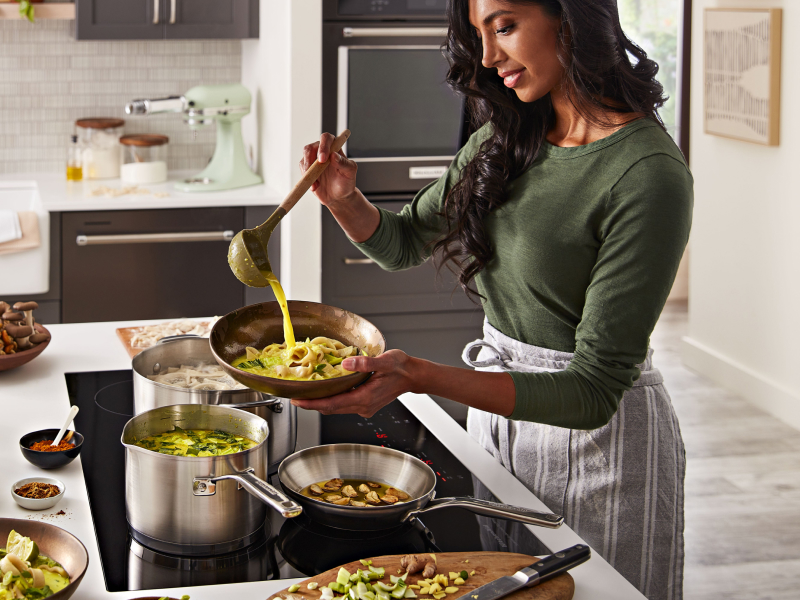
1. Size
Available in 30-inch or 36-inch versions, induction cooktops can fit in either small or large kitchen configurations and along your countertop. Larger cooktops may offer more burners, bridge elements or simply give you more space to maneuver large pots and pans.
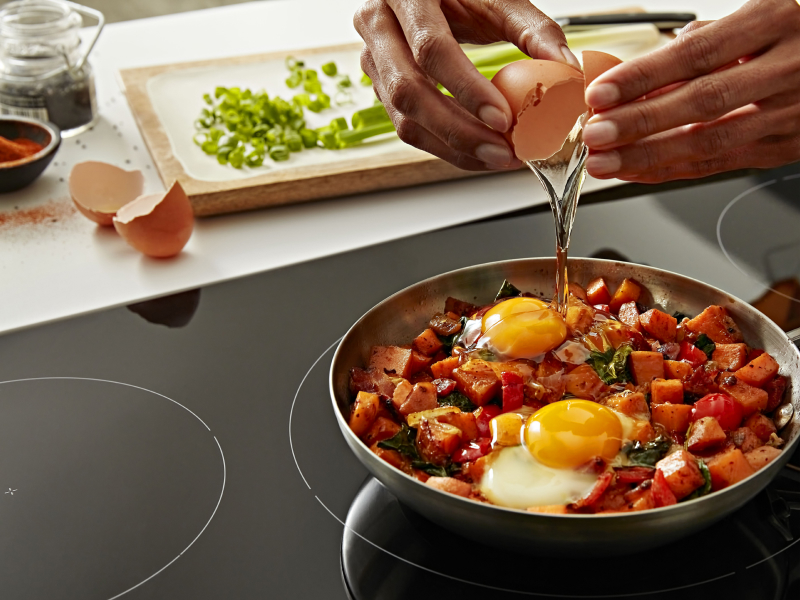
2. Style
When shopping for a new induction cooktop, consider your style and kitchen design preferences. Complement your kitchen aesthetic with black or stainless steel options, create an edge-to-edge monochromatic look with black induction cooktops, like this model from KitchenAid brand featuring touch controls, or make a statement with the contrasting stainless steel trim on a model like this KitchenAid® induction cooktop.
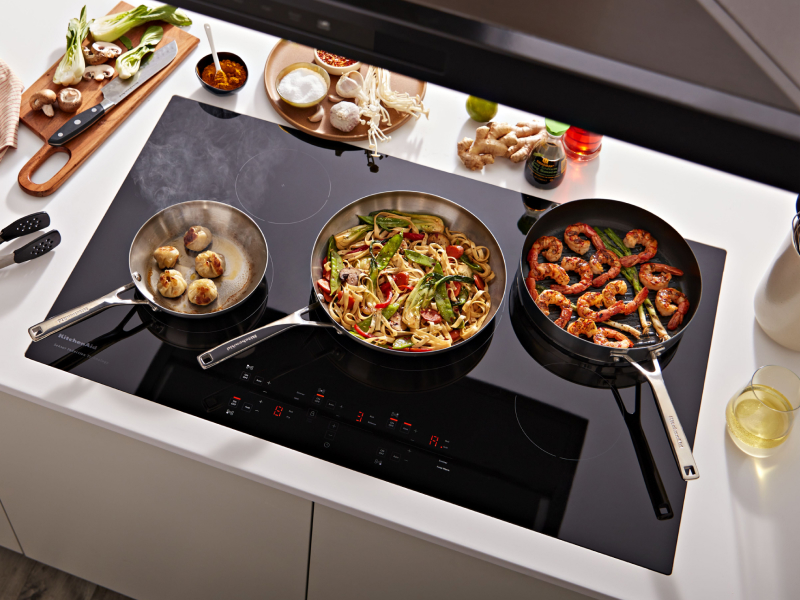
3. Number of Burners
With an option for two, four or five burners, you can choose the cooktop that best fits your making style. Additionally, bridge functions in select induction cooktops allow you to combine elements into larger cooking zones for both griddles and wider pans.
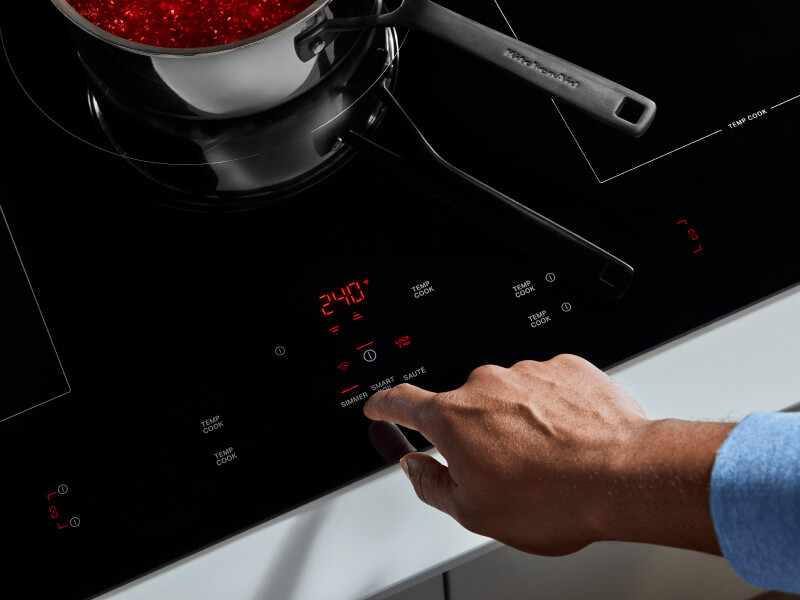
4. Features
Induction cooktops can come equipped with a number of impressive features, including various heat level settings that allow you to move seamlessly from melting to sautéing, features that help you choose the correct cookware for each element and technology that helps food cook with the right amount of heat at the right time.
KitchenAid® induction cooktops like this one feature Temp Cook™ Smart Presets that set and hold the ideal temperature for popular cooking methods and alert when to add ingredients, so you can perfectly sear salmon, gently simmer sauces and quickly boil water.
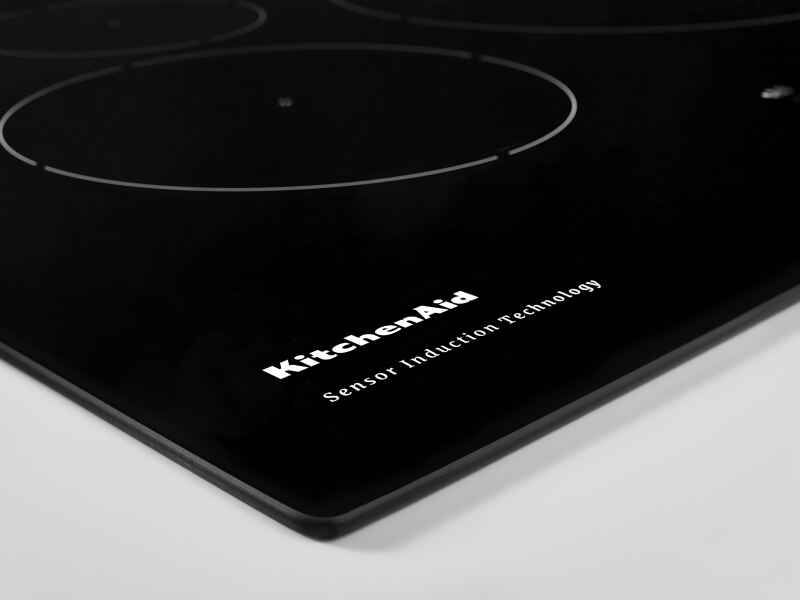
5. INSTALLATION
For a kitchen that feels thoughtfully refined, some induction cooktops are crafted to install completely flush with the countertop, creating a polished aesthetic. Some KitchenAid® induction cooktops, for instance, offer a Frameless Design that allows flush installation for a seamless look, or standard installation to fit an existing cooktop cutout.

6. VENTILATION
As with any cooktop, it’s important to think about how ventilation can support the way you cook, and how it fits into your kitchen’s overall look and feel. Consider a retractable downdraft hood—like these KitchenAid® vent hood models—that stay hidden within the countertop when not in use, then rise up when needed to help clear smoke and odors.
Depending on where your cooktop is installed, you may also explore other types of hoods. Under-cabinet vents, island range hoods, wall-mount canopies, or over-the-range microwave and hood combinations can all help keep the air clear while you create.


INDUCTION VS. ELECTRIC COOKTOP: WHAT’S THE DIFFERENCE?
The main differences between induction and electric cooktops include their heat source, energy efficiency, cooking speed, cookware compatibility and responsiveness. Despite both being powered by electricity, induction and electric cooktops differ in these important ways.
HEAT SOURCE
Electric cooktops heat the stove surface, which then heats the pan. Induction cooktops use magnetic fields to generate heat directly within compatible cookware, rather than heating the stove itself.
ENERGY EFFICIENCY
Induction cooktops create heat directly in your cookware, so there is little-to-no heat loss from the surface of the appliance to your dish, making them energy efficient. When cooking with regular electric cooktops, there can be some heat lost from the element that radiates heat through the surface of the cooktop.
PRECISE TEMPERATURE CONTROl
Induction cooktops offer exceptional responsiveness to temperature changes. Because the coil in induction cooktops does not generate heat on its own, you do not need to wait for the coil to cool when lowering the heat setting. This allows you to quickly go from a rolling boil to a gentle simmer.
COOKING SPEED
Generating heat directly within compatible cookware lets an induction cooktop reach high temperatures swiftly and cool down just as quickly. This rapid responsiveness can help you boil water fast and help control your cooking pace. Electric cooktops may take longer to achieve tasks like boiling, as it takes time to transfer heat from heated coils, through the cooktop and into cookware.
COOKWARE COMPATIBILITY
For induction cooking to work properly, you’ll need to use cookware that’s magnetic (also known as ferromagnetic). These pots and pans are either made from or contain a layer of material that a magnet will stick to, including enameled steel, cast iron or stainless steel designed for cooking. Electric cooktops, however, work with nearly any cookware, including aluminum, copper or ceramic.
SHOP KITCHENAID® INDUCTION COOKTOPS WITH TEMP COOK™ INDUCTION TECHNOLOGY
Induction cooktops from KitchenAid brand help give you more control when creating. KitchenAid® cooktops with Temp Cook™ Induction Technology let you set an exact temperature from 120°F to 400°F for precise control beyond standard high, medium and low settings. Dual sensors in the cooktop help keep your pan from overheating, so you can take on ambitious recipes with delicious results, batch after batch.


WHAT ARE THE BENEFITS OF INDUCTION COOKTOPS?
The benefits of induction cooktops include responsive and precise cooking, potentially less energy loss to the pan and easy cleanup with a relatively cool surface, which helps reduce the chance of baked-on spills. However, there are those who prefer the direct flame provided by gas cooktops while others enjoy the familiarity of radiant electric cooktops.
PRECISE AND RESPONSIVE COOKING: Induction cooktops respond almost instantly to temperature changes. Since the heat is generated directly in the pan—not from a hot coil beneath the ceramic glass surface—you can quickly dial down the temperature.
LESS ENERGY LOSS: Induction cooktops use electromagnetic energy to heat the cookware itself rather than the cooktop surface, so more energy goes directly into cooking your food with minimal heat loss.
FLEXIBLE COOKING ZONES: Some induction cooktops feature expandable cooking zones designed to adjust to different pan sizes, helping ensure more even heating across a variety of cookware. For instance, some KitchenAid® induction cooktops feature an Even-Heat™ Zone that add versatility to cook with large pans, like griddles, grill pans and braising pans, or two pans at two different temperatures. Unlike traditional round bridge elements with heating gaps, the rectangular zones heat evenly edge-to-edge, so the crepe in the back cooks just as beautifully as the one in the center.
COOLER COOKTOP SURFACE: Because induction cooktops directly heat the cookware, rather than the cooktop surface itself, the area around the pan stays relatively cool. This can make it easier to navigate the space when multiple cooks are in the kitchen, and can help prevent some splatters and spills from burning to the cooktop surface during cooking.
EASY CLEANUP: The smooth surface of an induction cooktop cools down quickly once the cookware has been removed, making post-meal cleanup simple. Some models may include features or finishes that make cleaning even easier. For instance, select KitchenAid® induction cooktops feature the WipeClean™ Coating that eliminates scraping, intense scrubbing and harsh cleaners, making this the easiest induction cooktop coating to clean.1 Just wet the surface with water and wait five minutes to easily wipe up splatters and spills.
1. When compared with cooktop with same heating technology at similar power output.
What Is the Best Cookware to Use on an Induction Cooktop?
The best cookware to use on an induction cooktop is made of metals that are induction-ready. Some examples include cast iron and stainless steel. There is also a simple test to determine whether your current pot or pan is induction-ready. If a magnet sticks to the bottom of your cookware, it can likely be used on an induction cooktop.
Shop KitchenAid® Induction Cooktops
Offering increased precision and responsiveness when you need it most, KitchenAid® induction cooktops support every stage of making. With added features on select models like the Power Boost Function to help you get to a rapid boil, you can continually push the boundaries of your culinary imagination.

